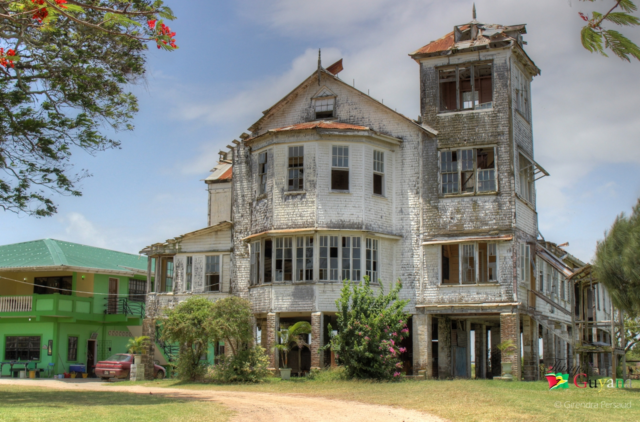By Sueann Wickham
Guyana’s landscape is not only adorned with natural wonders but also graced by historical family residences that bear witness to the nation’s rich past. In this week’s publication, we delve into the captivating stories behind some of Guyana’s most iconic family homes, each steeped in history and, in some cases, shrouded in mystery.
The 99 Window House: A grand colonial legacy
Located in the region of Berbice, the 99 Window House, also known as the Nandlall Saha House, is an architectural gem that stands as a testament to the grandeur of colonial-era residences. This mansion derives its name from its most distinctive feature: an astounding 100 windows that adorn its facade.
The house was constructed during the 19th century, a period when Berbice was a thriving centre for sugar production. Its opulent design reflected the prosperity of the sugar planters of that time. The mansion’s large windows not only allowed ample natural light to flood its rooms but also served as a status symbol, indicating the wealth and influence of its occupants.
The 99 Window House showcases a captivating blend of architectural styles that were popular during the colonial period. Its design features elements of both Dutch and British architectural traditions, a reflection of Guyana’s colonial history.
The Dutch influence is evident in the mansion’s distinctive stepped gable, a characteristic feature of Dutch architecture. Meanwhile, British architectural elements are seen in the overall layout and symmetry of the house.
Beyond its architectural grandeur, the 99 Window House provides a window into the history of Berbice and the sugar industry that once thrived in the region. During the colonial era, sugar was a major economic driver in Guyana, and the wealthy planters built impressive residences like this one.
The house likely hosted lavish gatherings and social events, where the elite of Berbice would congregate. It served not only as a place of residence but also as a hub of culture and society during that time.
Today, the 99 Window House stands as a reminder of Berbice’s colonial past and the wealth that was generated through the sugar industry. Visitors to Berbice are often drawn to the 99 Window House, marvelling at its unique design and the stories it holds within its walls. It serves as a living testament to the heritage of Guyana and the enduring legacy of those who shaped its history.
The Haunted Hague Mansion: A place of mystery and legend
Nestled in the heart of Berbice, the Hague Mansion is a grand colonial-era house that has earned a chilling reputation over the years. While the exact date of its construction remains uncertain, it is believed to have been built in the 1800s, during the height of the sugar plantation era in Guyana.
The mansion’s haunted status is the result of numerous eerie tales and unexplained phenomena reported by those who have visited or lived in the vicinity. These stories have made the Hague Mansion a magnet for paranormal enthusiasts and thrill-seekers.
One of the most common and spine-tingling reports regarding the Hague Mansion is the sighting of ghostly apparitions. Visitors and locals alike have claimed to see shadowy figures, often dressed in colonial-era clothing, wandering the mansion’s grounds or appearing in its windows.
Additionally, eerie sounds and mysterious footsteps have been reported by those who have ventured near the mansion after nightfall. Some visitors have described hearing whispers or disembodied voices, adding to the mansion’s unsettling ambience.
One of the most enduring legends associated with the Hague Mansion is that of the “Lady in White.” According to local lore, a spectral woman dressed in a white gown is said to haunt the mansion’s halls. Witnesses have reported seeing her drifting through rooms or standing silently by windows, her presence evoking a sense of unease.
The identity of this apparition remains a mystery, and theories range from tragic love stories to tales of plantation-era intrigue. Regardless of the origin, the Lady in White has become an iconic figure in the mansion’s haunted history. While many have reported unusual findings, the mysteries of the Hague Mansion persist, and its haunted status remains a topic of debate and fascination.
The Austin House: A Guyanese architectural gem
Austin House, a name resonating with history, is deeply connected to the legacy of Bishop William Piercy Austin (1807-1892). This iconic structure, located on High Street in Kingston District, has a story that dates back to the 19th century.

In 1842, the building was originally established as the Bishop’s residence, known as Kingston House. However, over the years, the original structure fell into disrepair, leading to its demolition in early July 1894. Construction for a new edifice commenced later that same month.
On October 5, 1894, the new structure, which we now recognize as Austin House, was officially handed over. This architectural marvel is credited to the construction expertise of John Bradshaw Sharples (possibly John Bradshaw) and reflects the colonial design trends of its time. With its steep roofs, Demerara windows, and six-paned Georgian windows, Austin House stands as a testament to the architectural aesthetics of the late 19th century.
During the tenure of Bishop William Swaby, which extended until 1899, the building was referred to as Bishop’s Court. In the 1930s, a significant transformation occurred as the ground floor was enclosed to create additional office space. Subsequent renovations in the 1950s included the addition of stained glass windows over the main entrance, enhancing the building’s overall charm.
The mansion’s architectural style reflects the influence of British colonial design. It features characteristic elements such as large windows, intricate woodwork, and spacious verandas. The Austin House, like many colonial-era mansions, would have hosted lavish gatherings and social events, serving as a centre of culture and society during that period.
In 2012, Austin House underwent substantial restorative works under the guidance of architect Rawle Jordon, ensuring the preservation of its historical significance and architectural splendour.
Guyana’s historical family residences are not mere structures; they are repositories of stories, legends, and the essence of a nation’s history with each residence offering a unique glimpse into Guyana’s past. These homes are a testament to the enduring spirit of the people who lived within their walls and the mysteries that continue to captivate the imagination.
They also remind us that history is not confined to textbooks but is also etched into the very structures that grace our landscapes, waiting to be discovered and cherished by generations to come.









